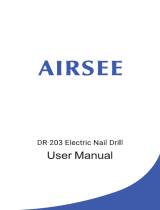
, Automatic ice maker...
l The ice maker will not operate until the freezer
If you have the automatic ice maker accessory,
is cold enough to make ice. This can take
or if you plan to add one later (Part No. ECKMF-861,
overnight.
there are a few things you will want to know:
l Because of new plumbing connections, the first
l The ON/OFF lever is a wire signal arm.
ice may be discolored or off-flavored. Discard
Downfor making ice automatically.
the first few batches of ice.
Up...to shut off the ice maker.
l If ice is not being made fast enough and more
DO NOT TURN ICE MAKER ON UNTIL IT IS CON-
ice is needed, turn the Refrigerator Control
to-
NECTED TO THE WATER SUPPLY.
ward a higher number. Wait a day and, if neces-
sary, turn the Freezer Control toward A.
l The dial or lever on the side of the ice maker
changes the size of the cubes.
l If you remove the ice bin, raise the signal arm to
shut off the ice maker. When you return the bin,
l Shake the bin occasionally to keep cubes sepa-
push it all the way in and lower the arm to the ON
rated, and to obtain increased storage capacity
position.
l It is normal for ice crescents to be attached by a
l If cubes are stored too long, they may develop
corner. They will break apart easily.
an off-flavor...like stale water. Throw them away
They will be replaced. Cubes in the ice bin can
also become smaller by evaporation.
l Good water quality is important for good
ice
LOWER RAISE
quality. It is not recommended that the ice maker
SIGNAL SIGNAL
be connected to a softened water supply Water
ARM TO
ARM
TO
softener chemicals such as salt from a malfunc-
START IT
STOP ICE
tioning softener can damage the ice maker
mold and lead to poor quality ice. If a softened
l You wil
maker is
water supply cannot be avoided, then it is impor-
working. You’ll hear ice fall into the bin. Don’t let
tant that the water softener be well maintained
these sounds bother you.
and operating properly.
I^ii~~~~l,~--.=-*m~r,,~14s~, ,bWb ,,y1 ,W.,:~“.a¶UIIY:‘i’~r~,i h El, w-19 c.Y,.pI ,‘Nik Sk! Da* “1_?I- i?. : I * .’ I’
Your new refrigerator may make sounds that your old one didn’t.
Because the sounds are new to you, you might be concerned about them.
Don’t be. Most of the new sounds are normal. Hard surfaces like the floor,
walls and cabinets can make the sounds seem louder.
The following chart describes the kinds of sounds that might be new to
you, and what may be making them.
Possible Sounds:
Probable Causes:
,... -_ . . . . ,1
,r; rm*- ,a *...
-w--r-/
.----*ml,,l-,n*___(
-I__- .II~w‘-*““~lY~I.-. ---, _
l
Slight Hum, Sofi Hiss:
You may hear the refrigerator’s fan motor and moving air.’
_ .dZ ..ie-->mY.am. /7.,I -
.w.i, ,d--Mz.s--*-
--m.L&~-~-~-__P_m
l
Clicking or Snapping
G.I=.C-LT .,I,- -/.
The thermostat makes a definite click when the refrigerator stops running.
Sounds:
It also makes a sound when the refrigerator starts. The defrost timer will
click when the defrost cycle starts and stops.
2 ---*“-a1 -.*--
-mm--
*- Water Sounds:
When the refrigerator stops running, you may hear gurgling in the tubing
for a few minutes after it stops. You may also hear defrost water running
into the defrost water pan.
.:
Lx-mm.
---==-l=sl =a--x. ,.l-.Cl-a.-- .,lUI. 1.w.s .,s-. I m..-. s- ,h_., Ij _I~.i,S,ir .,
l
ice Maker Sounds:
If your refrigerator has an ice maker you may hear buzzing (from the
,,~-r_. _
- trickling water
Water
Valve), trickling water and the clatter of ice dumped into the bin.
- thud (clatter of ice)
rwnr i,. 2 L_..___*ll_,,_q.l,E)_l”~~-~-
7. s__-~--*-lryIyu*.~...~.- “yesaz,~..-v5~il~,~l. I
l
Running Sounds:
Your refrigerator has a high-efficiency compressor and motor. It will run
.>r i >. ,
longer than older designs. It may even seem to run most of the time.
Energy savingTic:--‘--’
W.-w-
-“,x-~. -,> .I
You can help your refrigerator use less electricity.
l It is a waste of electricity to set the refrigerator
l Check door gaskets for a tight seal. Level the
and freezer to temperatures colder than they
cabinet to be sure of a good seal.
need to be. If ice cream is firm in the freezer and
l Clean the condenser coil regularly.
drinks are as cold as your family likes them, that’s
l Open the door as few times as possible. Think
cold enough.
about what you need before you open the door,
l Keep the Power Saving Control on CONSUMES
Get everything out at one time. Keep foods orga-
LESS ENERGY unless moisture forms on refrigerator
nized so you won’t have to search for what you
exterior.
want. Close door as soon as food is removed.
l Make sure your refrigerator is not next to a heat
l Go ahecd and fill up the refrigerator, but don’t
source such as a range, water heater, furnace,
overcrowd it so air movement is blocked.
radiator or in direct sunlight.
7



















